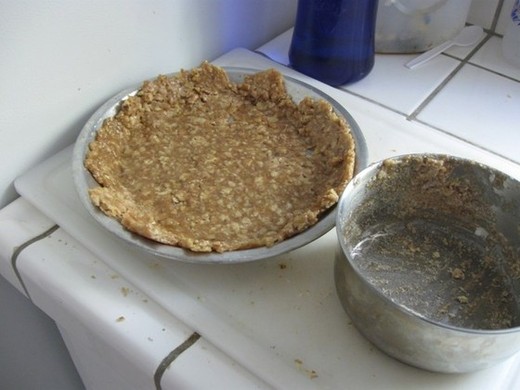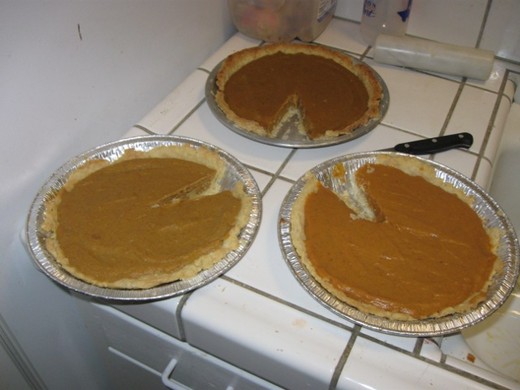The pumpkin pie project
I am on a quest to create the perfect pumpkin pie. I know what you’re thinking: “What’s wrong with pumpkin pie?” Nothing is wrong with pumpkin pie. It’s just not perfect. Yet.
My gripe is with the crust. The buttery, flaky bite of a traditional pie crust goes perfectly with apples or pecans, but in a pumpkin pie it seems little more than a necessary bottom layer, like the rubber on the sole of your shoes. I picture a sweet, flavorful, crunchy crust, a crust that deserves its place in the pie.
I was unable to find any recipes for the pie in my head. There were crumb crusts, and nut flour crusts, but no crunchy chopped nut crusts. Additionally, I wanted to avoid sweetened condensed milk, since I’m lactose intolerant and sweetened condensed milk is basically lactose in a can.
So I began to experiment.
One, Two, & Three
Experiments one, two, and three began the foray into the deep world of pie crust. I created number one by mixing chopped walnuts, butter, and sugar, and then added different ratios of flour to this to create experiments two and three. Then they went into the oven.
Predictably, number one came out as a bunch of nuts sitting on a charred film of sugar. Number two was basically pie crust with sugar, which is equivalent to a cookie without eggs. Number three was the same as number 2, except with less sugar. I deemed all three wholly unsatisfactory.
Four and Five
Experiments four and five continued with the crust. I began by melting sugar in a saucepan with butter and a few drops of water, and cooked it until the sugar began to carmelize. I mixed in some cinnamon and rice krispies (the latter being a cheap substitute for walnuts) and dumped the result out on a pan. It formed a hard, crunchy candy much like I envisioned.
Experiment five was to put half of the candy bits in the oven for a few minutes. They came out delicious, thanks to the additional carmelization.
Six
Based on this success, I made my first attempt at a complete pie. My plan was to bake the pie at a slightly lower temperature - 325°F - so that the crust would remain solid while the pie baked. Going higher would cause the crust to carmelize further or outright melt. Sugar melts around 365°F, and an oven has a few degrees of swing above and below its set temperature, so 325 felt like a reasonable choice.

I made a traditional pie filling, following the recipe on the Libby’s pumpkin can (except for substituting lactose-free milk and sugar for the sweetened condensed milk). The pie tasted good. But the crust completely dissolved in the filling, leaving only a layer of nuts at the bottom. Failure!
Seven
Two days later, I repeated experiment six, but mixed a small amount of flour into the crust along with the nuts. The texture of the crust was definitely improved - less like jawbreaker candy and more like a crunchable crust. Baked, however, it was an equal failure: just another gooey mess of sugar, nuts, and pumpkin glued to the pie plate.
Eight, Nine and Ten
I had a decent crust; I just needed a way to bake the pie without ruining it. So I began to investigate alternative pie fillings that don’t require baking. Experiment eight used vanilla pudding:
- 1 pkg. lemon or vanilla whipped dessert mix
- 1/4 c. sugar
- 1 tsp. pumpkin pie spice (I used separate cinnamon, nutmeg, cloves and ginger)
- 1 c. canned pumpkin
- 1/2 c. cold milk
- 1/4 c. cold water
Mix ingredients and whip as you would pudding. Pour into pie shell and refrigerate. (from cooks.com)
I didn’t care much for the pudding pie. It was good, but the vanilla taste was out of place and the texture was that of pudding, and not of pie. However, a surprising number of people preferred it to the others.
Experiments nine and ten used a boiled custard poured into the pie shell. Experiment ten was broiled for fifteen minutes after the custard was poured into the shell, while nine remained unbaked.
- 2 ½ c. cooked pumpkin
- 2 c. milk
- 1 ½ c. sugar
- 4 tbsp cornstarch
- 2 eggs
- 1/2 tsp. salt
- 1/2 tsp. cloves
- 1/2 tsp. ginger
- 1 1/2 tsp. cinnamon
- 1/4 tsp. nutmeg
- 1 (10”) baked pie shell
Combine, boil. (from cooks.com)

After comparing nine and ten, I baked number nine. Boiling the custard at 212° F doesn’t produce the same chemical reactions (particularly the carmelization of sugar) as baking it at 350 or 400 degrees. As a result, the boiled filling is bland in comparison to the baked pie.
Eleven
Experiment eleven was a nut-crust repeat of experiment ten, which I had done with a plain crust due to my limited supply of time and walnuts. To guard against possible custard seepage and the subsequent crust dissolution, I whipped up an egg, spread it on the crust, and baked it for a few minutes.
The egg helped. There were discernible chunks of candy and nuts on the bottom of the pie, rather than an amorphous sugary ooze. But the crust was so lumpy that coating it with egg was as futile as using driveway sealer on a gravel road.
Twelve
A good scientist will tell you to never change more than one experimental variable at a time, but I needed to accelerate this process. Experiment twelve made every deviation possible. I tried a new crust recipe, mixing nuts, sugar, butter, and flour, and baking the result like a regular crust. The recipe was much faster to mix and didn’t require the stovetop, which were important gains over my melted sugar crust. Rather than using canned pumpkin, I cooked a butternut squash for the filling, and baked it like a traditional pie.
The result was mediocre. The crust barely held together and was neither a tasty candy crust nor a respectable flour crust. It clung to some tepid middle ground, sacrificing taste for convenience. The squash made a decent pie, but the spices were insufficient and the final result merely ok.
Thirteen and Fourteen
Thirteen was a minor innovation on experiment eleven. I refined my technique for making the crust and tweaked the ratio of ingredients. I used the boiled-baked filling recipe, and added some gelatin to help it set. The gelatin didn’t help much, but the crust was a little more solid and pie was good.
Fourteen was a repeat of nine (the pudding pie), except using “seasonal exclusive” pumpkin flavored pudding instead of vanilla. The result, obviously, tasted very much like pumpkin. Equally obvious, the texture was still that of pudding. It was tasty, even delicious, but I couldn’t accept it. It was pudding with a crust, not pumpkin pie.
Fifteen
I nailed the crust on fifteen. It was crunchy, sweet, and flavorful. It held together and barely stuck to the pie plate. The filling was excellent too - I used the boiled filling with half a packet of vanilla stovetop pudding, which lent a bit of creaminess to the custard. However, the filling barely set. Maybe I needed more cornstarch, or more pudding, or less milk. Or maybe I shouldn’t have taken it for a fourteen mile bike ride minutes after I took it out of the oven.
The recipe today
This saga has come to an end, but the story isn’t over yet. I have a sugar pumpkin sitting on my counter, so it won’t be long until experiment sixteen. But for now, here’s my current leading recipe:
Crust
- 1 c. chopped walnuts
- 1/3 c. flour
- Cinnamon, nutmeg, and salt to taste
- 3 tbsp butter or margerine
- ~ 1 tbsp water
- 1 c. sugar
- 1 egg
First, chop the nuts and mix them with the flour and spices in a small bowl. Set aside. Grease or spray your pie plate, and prepare any utensils you want to spread out the pie crust. I find that the end of a marble rolling pin works well.
Melt the butter in a saucepan along with the water. The amount of water isn’t critical, as it will all boil away. Pour in the sugar and stir frequently.
When the sugar begins to carmelize (turn a light golden color), remove the pan from heat and pour in the nut/flour mixture. Stir quickly and then dump the mixture into the pie plate. You will have to work quickly to form the crust in the pan before it hardens.
Beat the egg and use it to coat the crust. You may not need the entire egg; the remainder can be added to the filling. Bake the crust for 10-15 minutes at 350° F.
Filling
- 2 ½ c. cooked pumpkin
- 2 c. milk
- ¾ c. sugar
- 4 tbsp cornstarch
- ½ package of pudding mix
- 2 eggs
- Cinnamon, cloves, nutmeg, ginger, and salt to taste.
Mix all ingredients in a saucepan, and then bring to a boil. The custard will spatter and make an enormous mess.
When you feel the time is right, pour the custard into the crust and bake for ~20 minutes at 350° F.
Thanks for reading. Keep experimenting, friends!